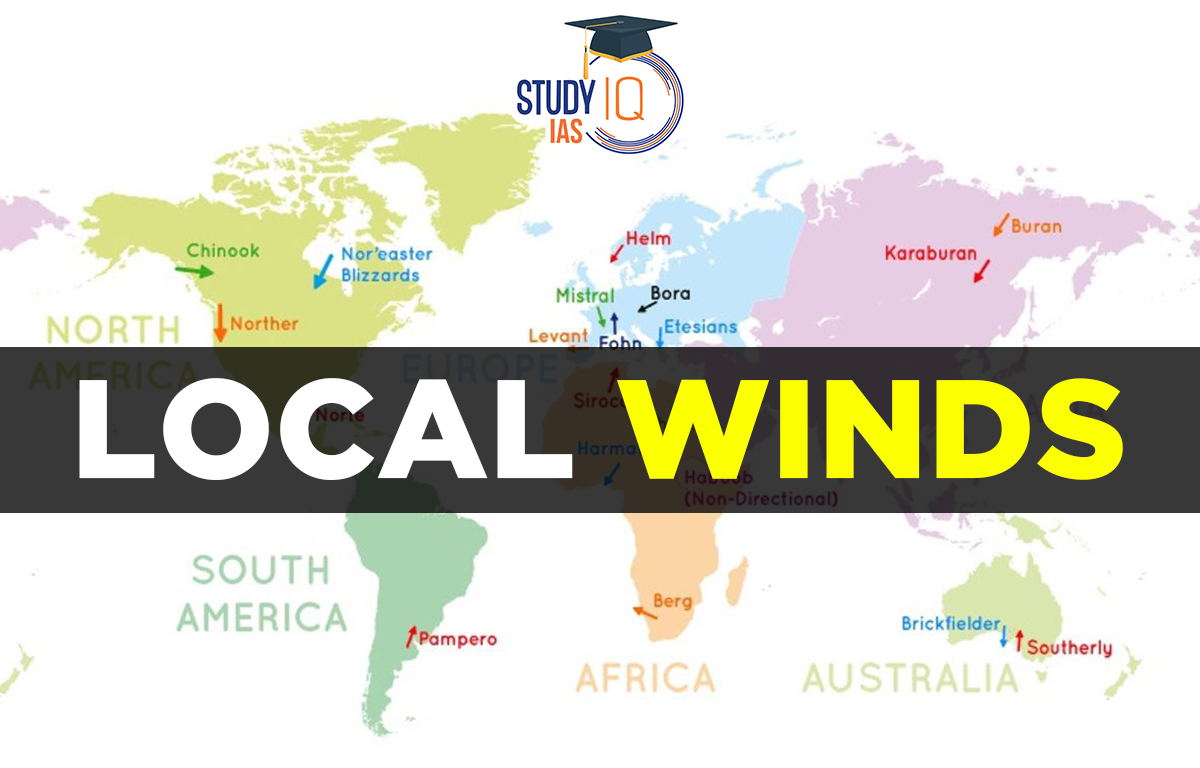Table of Contents
Local Winds
Local winds are winds that blow over small areas covering tens to hundreds of kilometers. They happen when air moves between high and low-pressure areas like nearby oceans, lakes, or mountains, can influence these winds. Local winds can affect the weather and climate of a region, and they can be classified as periodic (happening regularly) or non-periodic (happening irregularly). Each type of local wind is a bit different from others, and they can affect the climate of a region. These local winds are important for the weather and climate in their specific areas. Many well-known local winds exist in different parts of the world which is described below.
Read More: Types of Winds
List of Local Winds
Here we are providing a List of Major Local Winds and their Type or Nature:
| Name of Local winds | Type/Nature of Local Winds |
| Harmattan (Guinea Doctor) | Hot and Dry wind |
| Khamsin | Hot and Dry wind |
| Foehn | Hot and Dry wind |
| Solano | Hot and Moist wind |
| Siroco | Hot and Moist wind |
| Chinook (Snow eaters) | Hot and Dry wind |
| Bora | Cold and Dry wind |
| Mistral | Cold wind |
| Punas | Cold and Dry wind |
| Blizzard | Cold wind |
| Purga | Cold wind |
| Levanter | Cold wind |
| Santa Ana | Hot wind |
| Norwester | Hot wind |
| Karaburun (black storm) | Hot and Dusty wind |
| Calima | Dust-laden Dry wind |
| Elephanta | Moist wind in monsoon |
Read More: Pressure Belts
Hot Local Winds
1. Loo
It is hot and dry. These winds blow strongly over the northern plains of India and Pakistan in the summer. They come from the west and move east. You usually feel them in the afternoons, and temperatures can reach between 45°C and 50°C.
2. Foehn
The “Foehn” is a strong, dry, and warm local wind. It forms on the side of the Alps that doesn’t face the wind. This wind happens because of pressure differences that push air up and over the mountains. As the air rises, it can cause rain on the windward side. Once it crosses the mountain peak, it comes down on the other side as a warm and dry wind. The temperature of these winds ranges from 15°C to 20°C. This helps melt snow and prepares the grassland for animals to graze.
3. Chinook
The “Chinook” is a hot and dry local wind that blows down the eastern slopes of the Rocky Mountains in the U.S.A. and Canada. The name “Chinook” means “snow eater” because it helps melt snow early in the season.
4. Sirocco
The “Sirocco” is a hot, dry, and dusty wind that comes from the Sahara Desert. It is known as the spring wind. After crossing the Mediterranean Sea, it cools down a bit because of the moisture from the water. It has different local names, like Leveche in Spain, Khamsin in Egypt, and Gharbi in the Aegean Sea region.
5. Harmattan
Harmattan is a strong, dry wind that comes from the Sahara Desert and blows over northwest Africa. It is hot, dry, and dusty. This wind gives a nice break from the humid heat and is good for people’s health, which is why it is also called “the doctor.”
Read More: Atmospheric Pressure
Cold Local Winds
1. Mistral
Mistral’ is a cold wind of the Alps. It moves over France towards the Mediterranean Sea through the Rhone valley. They are cold, dry, and of high velocity. They reduce the temperature below the freezing point.
2. Bora
Bora’ is a cold, dry, high-speed north-easterly wind blowing down from the mountains in the Adriatic Sea region.
3. Blizzard
Blizzard is a violent wind. It is freezing, wind-laden with dry snow.
Read More: Chemical Weathering
Local Winds Importance
- Waves are powerful and can generate energy by driving large turbines.
- Local winds are a clean and renewable resource that helps reduce pollution.
- Local winds move ocean currents, like the Antarctic Circumpolar Current, circulating cold, nutrient-rich water around Antarctica.
- Local winds affect weather and climate by balancing temperatures and humidity in nearby areas.
- They help circulate oxygen in the air we breathe.
- Local winds carry moisture over mountains, leading to rainfall as they rise and cool.
- These winds help move materials like seeds, pollen, sand, and dust across the land.
Read More: Types of Rocks
Local Winds UPSC
The air movement between low-pressure and high-pressure systems within confined spaces is what generates local winds. Each type of wind has its own distinct appearance because there are so many different kinds. It is crucial to comprehend what causes local winds because they frequently have a considerable impact on the local climate.
Because they have an impact on climatological traits like visibility and humidity, local winds play a significant role in weather and climate, both individually and collectively. Above all, they significantly affect the nation’s economy. You will learn about Local Winds in this article, which will help you with your preparation for the UPSC Civil Service exam in Geography Syllabus.


 Role of Teachers in Educations, Student ...
Role of Teachers in Educations, Student ...
 India's achievements after 75 years of I...
India's achievements after 75 years of I...
 Bal Gangadhar Tilak Biography, Achieveme...
Bal Gangadhar Tilak Biography, Achieveme...

























